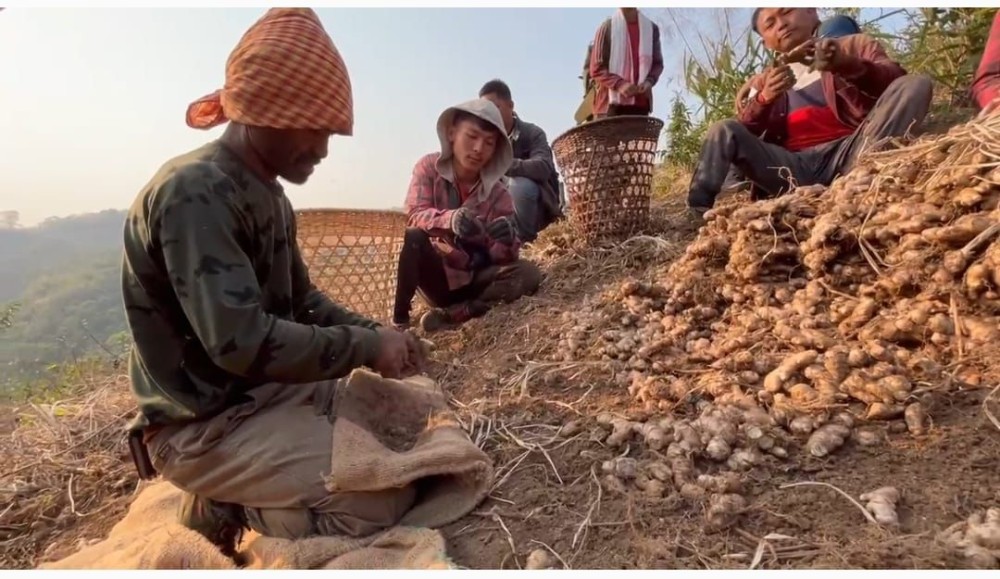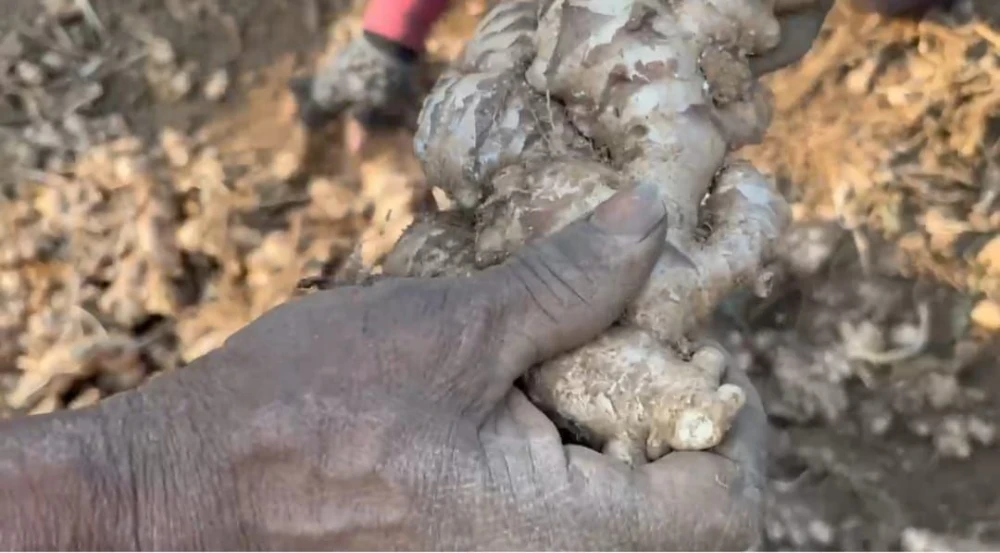
Helvellyn Timungpi
“When ginger prices fluctuate, it is very difficult to make ends meet, as we are mostly dependent on ginger,” said Hoihnu Guite, a widow with five children and elderly in-laws she must care for.
In her village, perched high atop the Singhason hills, one of the tallest peaks in Assam, ginger isnt just a crop-it’s the lifeline. Built way back in 1932, Jawllian, a remote yet resilient village is inhabited by the Kuki tribe. Home to nearly 60 families, this picturesque settlement thrives amidst the clouds and rolling hills, where ginger cultivation forms the backbone of their livelihood. According to one of the residents Thangkhanlal Guite, more than 90 percent of them are dependent on it.
For generations, the people of Jawllian have relied on farming, ginger emerging as their primary crop. They also grow their own vegetables, fruits and rice. The challenging terrain, lack of proper road and distance from urban area have made agriculture not just a means of survival but also a way of life that defines the tribe’s identity. Despite the difficulties of mountain farming-from unpredictable weather to low market prices, the villagers continue to work tirelessly on their fields.
As I delved deeper into their way of life, the villagers shared that, though development is a far cry and most households depend on ginger cultivation, the village also takes pride in the sons and daughters who have gone on to serve the nation. From a politician who became a member of the Assam Legislative Assembly Khaizasong Guite to officers in the Indian Army and Navy, police officers to top positions in government departments, Jawllian has quietly contributed to the country beyond its hills though education remains a challenge and the village has only a primary school. “I live in Manja with my siblings for schooling,” said Rose (name changed) a young girl from the village. The nearest markets are Longnit an Manja-about 30 kilometres away. So families often juggle between earning a livelihood and ensuring education for their children. Many young people have had to move to Manja, Diphu and other towns in search of better opportunities.
Though most of the villagers depend on ginger cultivation, the situation has worsened in recent years due to ginger diseases, which farmers believe spread easily because they do not use chemicals or pesticides.

“Every year, forests are cleared in January and February to prepare the fields. Ginger seedlings are planted between March and May, and weeding is carried out during July and August. The crop requires immense hard work, but despite the effort, prices remain discouragingly low,” Thanghau Guite, sarkari gaonbura of the village stated.
According to him, this year, ginger prices fell to as low as Rs. 25 per kilo. In earlier years, prices often reached 80-100, but fluctuations have made the crop unreliable. Farmers recall that prices even dropped to Rs. 5 per kilo at times. According to villagers, the rates briefly rise during the MP elections, and decline steadily until the next MP elections.
“Ginger is our main crop. We also grow paddy, vegetables and fruits, but they are not enough to sustain us. Often, we are forced to borrow in advance from the Mahajon,” said Sehkhohao Guite, the village headman, referring to traders who often step in when farmers struggle to make ends meet. On average, a household harvests 50-100 tins of paddy-the tins being old rectangular oil cans, each holding 15-18 kilograms of grain,which is insufficient for annual consumption. It is backbreaking work, often done without machines, entirely dependent on the strength and determination of farmers.
Ginger and jhum cultivation involve clearing forest land, which is often misunderstood as forest destruction. However, Tollen Hangsing, a local villager, explained that no pesticides were used, and after one year of farming, the land is left fallow to let the forest regenerate. “We rotate plots and return only after the forest grows back,” he says. He adds, “If we were destroying the jungle, there wouldn’t be any left-but look around, we’re still surrounded by green.”
Adding to these struggles is the issue of connectivity. Due to poor road conditions, vehicles can reach the village only during winter. In summer, especially during the rainy season, villagers are forced to carry their produce on foot, walking long distances through muddy tracks. Vehicles only pick them up as far as Mimbung-another Kuki village located around 15 kilometres from Jawllian-making transportation of farm produce both exhausting and costly.
Bholaram Swami, a ginger trader in Manja since 1994 confirmed this pattern. “For decades, village have borrowed in advance from me-not just for farming, but also for food, medical treatment, and their children’s education,” he said.
He added that ginger from Karbi Anglong is among the finest in the world, much of it transported to Siliguri and other parts of West Bengal. However, the market favors appearanece over quality. “Customers usually prefer shiny ginger, which is produced using pesticides. Organic ginger, though far healthier, never looks as attractive,” he explained.
Despite these challenges, Swami urged farmers to continue organic practices. “Organic ginger may not shine, but it does not rot. If stored for months, it simply dries up instead of decaying-unlike ginger grown with chemicals,” he said.
Yet, despite of these hardships, the people of Jawllian endure. Their resilience, carved into the rugged slopes of the Singhason Hills, is a story of survival, aspiration, and hope for a better tomorrow.



